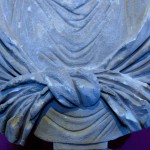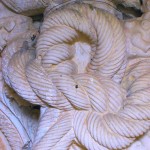 Though it seems difficult to tie a knot in stone, it has been done by sculptors since antiquity—most notably in the tied sashes and knotted shawls of Roman statuary. The finest symbolic knots, however, are found in Portugal and were made around the time of Dom Francisco d’Almeida’s murder. His tragic death—sadly underestimated and misrepresented for five hundred years—is what ties my story together.
Though it seems difficult to tie a knot in stone, it has been done by sculptors since antiquity—most notably in the tied sashes and knotted shawls of Roman statuary. The finest symbolic knots, however, are found in Portugal and were made around the time of Dom Francisco d’Almeida’s murder. His tragic death—sadly underestimated and misrepresented for five hundred years—is what ties my story together.
 The knot on the book cover comes from the same period and can still be seen at Belem Tower—a fort protecting the old entrance to Lisbon harbour. Over two centuries, while the Portuguese expanded their empire in East Africa and South Asia, outbound ships sailed passed this symbolic knot. I chose this knot because it represents relationships between East and West, mysticism and rationalism, and between an Old World and the New.
The knot on the book cover comes from the same period and can still be seen at Belem Tower—a fort protecting the old entrance to Lisbon harbour. Over two centuries, while the Portuguese expanded their empire in East Africa and South Asia, outbound ships sailed passed this symbolic knot. I chose this knot because it represents relationships between East and West, mysticism and rationalism, and between an Old World and the New.
 Manueline knots (so named for King Manuel I) reveal Portugal’s desire to follow in the footsteps of the Knights Templar. These knots represent a unity among military Orders—from as far afield as Tomar, Windsor, Bruges, Santiago de Compostela and Jerusalem—and the unbroken continuity between crusaders and seafarers, soldiers and explorers, and between the first defenders of the faith and those willing to explore new ideas.
Manueline knots (so named for King Manuel I) reveal Portugal’s desire to follow in the footsteps of the Knights Templar. These knots represent a unity among military Orders—from as far afield as Tomar, Windsor, Bruges, Santiago de Compostela and Jerusalem—and the unbroken continuity between crusaders and seafarers, soldiers and explorers, and between the first defenders of the faith and those willing to explore new ideas.
 To my mind the knot symbolises a long-standing relationship, as between couples in a marriage. One tied in stone reveals an enduring bond—a relationship made to outlast the living. A stone knot is made to survive long into the future. Knot of Stone relates the story of those who share such an enduring bond, interwoven through time, and how their lives changed the political balance of power and the course of world history.
To my mind the knot symbolises a long-standing relationship, as between couples in a marriage. One tied in stone reveals an enduring bond—a relationship made to outlast the living. A stone knot is made to survive long into the future. Knot of Stone relates the story of those who share such an enduring bond, interwoven through time, and how their lives changed the political balance of power and the course of world history.
Nicolaas Vergunst



Wow, exactly what I was looking for, thanks for posting this. “Never say that marriage has more joy than pain.” Euripides (438BC).
Incredible contribution, neatly tied together, I truly anticipate posts from you.
Too many compliments, too little space—thanks!